It’s an all-out war between the robotic residents of Earth and the endless spawn of a moon-sized glob of flesh in the sky called the Megabeast! I was skeptical of a Metroidvania roguelike because I generally prefer it when games with procedural generation only last about 30 minutes per run. However, while a successful run of A Robot Named Fight does indeed take about an hour, the game does a fantastic job of keeping things fresh by changing up the obstacles you encounter based on the powers you obtain. Sometimes this just amounts to adding in doors which require a certain type of weapon to open, but it also means things like adding in dark rooms if you get a light source and high barriers if you get a jump upgrade. It’s delightfully gross, surprisingly varied, and an all-around awesome game about becoming fight enough to take on cosmic abominations.
A Robot Named Fight definitely takes after the Metroid side of things. The mechanical protagonist is rather tall, armed with an energy gun, and has a bit of momentum to their movement which can take a while to get used to. Even the way you can crouch and use the shoulder buttons to aim diagonally has a distinctly Metroid vibe to it. This is to say nothing of the many doors which can only be opened with certain types of weapons, the way you gradually delve deeper as the game progresses, and the fact that vertical corridors are just about as common as horizontal ones.
Of course, plenty of differences exist as well. While the inclusion of procedural generation is the most obvious change from the formula, I’d say that Fight’s fragility has the most impact. Despite being made of metal, Fight only starts with a max health of eight and the few health upgrades you might stumble across only raise this total by two points each. True, most enemies only hit for a single point of damage, but a short amount of invincibility time means groups of enemies can rapidly drain your bar and when attacks do hit for more you really feel it.
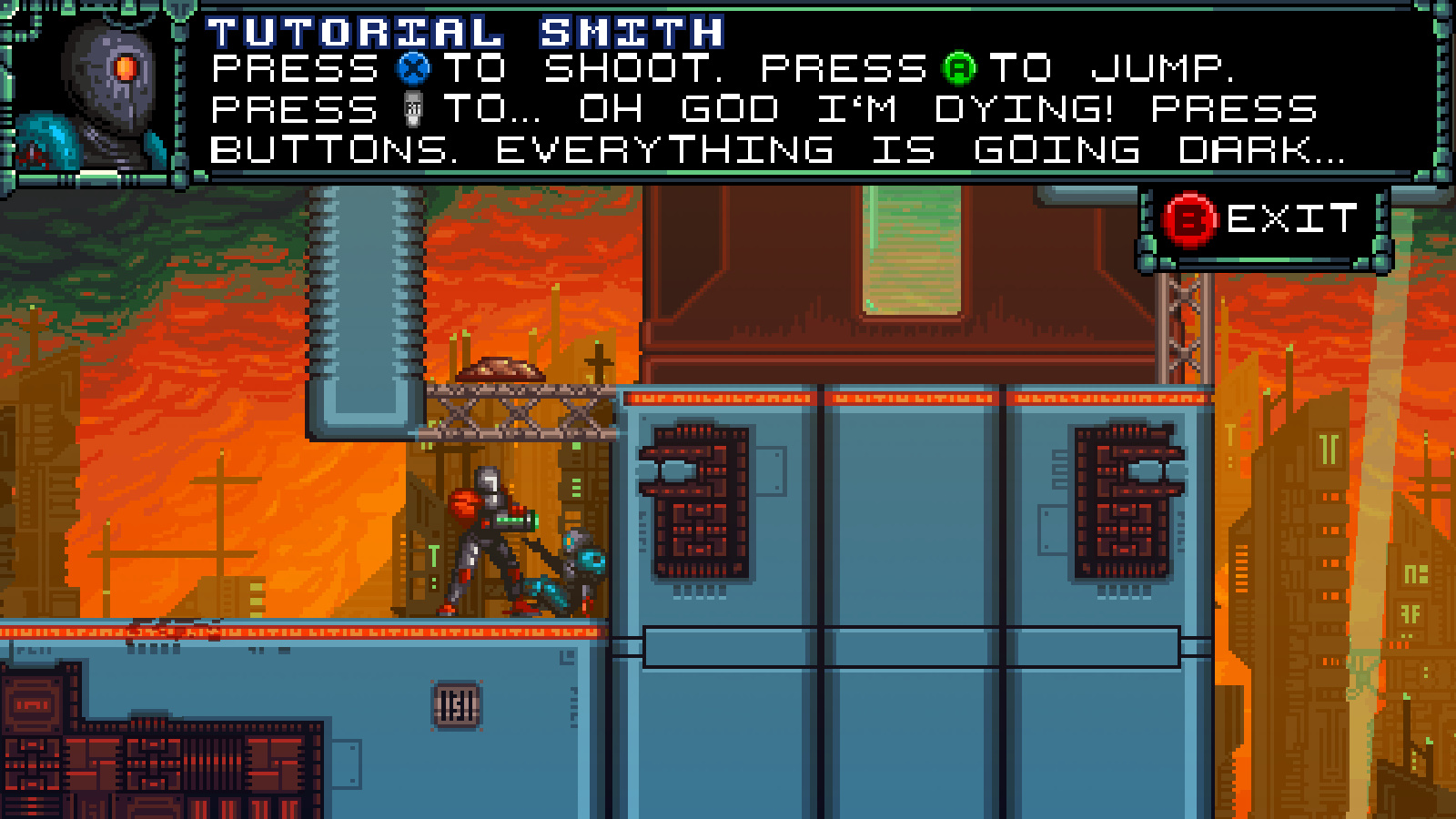
The ease with which you can die combined with the added risk of a single death (potentially) ending an entire run greatly affects how the game is played. While the way A Robot Named Fight revels in deliberately cheesy, over-the-top body horror makes it easy to assume that this is the type of game where you’re meant to rush in with guns blazing, its design encourages a much more careful approach.
It’s best to minimize the number of enemies you’re simultaneously fighting at any given time and there’s no shame in farming easier enemies for health refills if you need them. Diagonal aiming is very important, especially in vertical rooms, as it often allows you to avoid a fight altogether by shooting at enemies from positions they can’t reach. This isn’t to say that the whole game is a matter of painstakingly inching forward, but playing defensively definitely helps in a game where a single mistake can rapidly snowball into losing a huge chunk of your health.
The procedural generation is a crucial component to any roguelike, so how good is it here? It’s handled well for the most part, but there are some snags which you start to notice after a few runs. The map consists of four distinct areas plus the final boss itself. The first area is rather small and mostly linear every time, but the other three are all rather maze-like.
Though every area has plenty of optional upgrades to discover, the general goal of each is to find a specific upgrade which will let you access that area’s boss and in turn use an upgrade found in a room beyond the boss to reach the next area. The final boss itself is located beyond a vertical shaft in the very first area and can only be reached with the upgrade guarded by the fourth area’s boss; the home stretch of any given run is the one point at which you get to fly through rooms, leaving a trail of blood and gore in your wake, as you quickly backtrack through old areas with all your new powers.
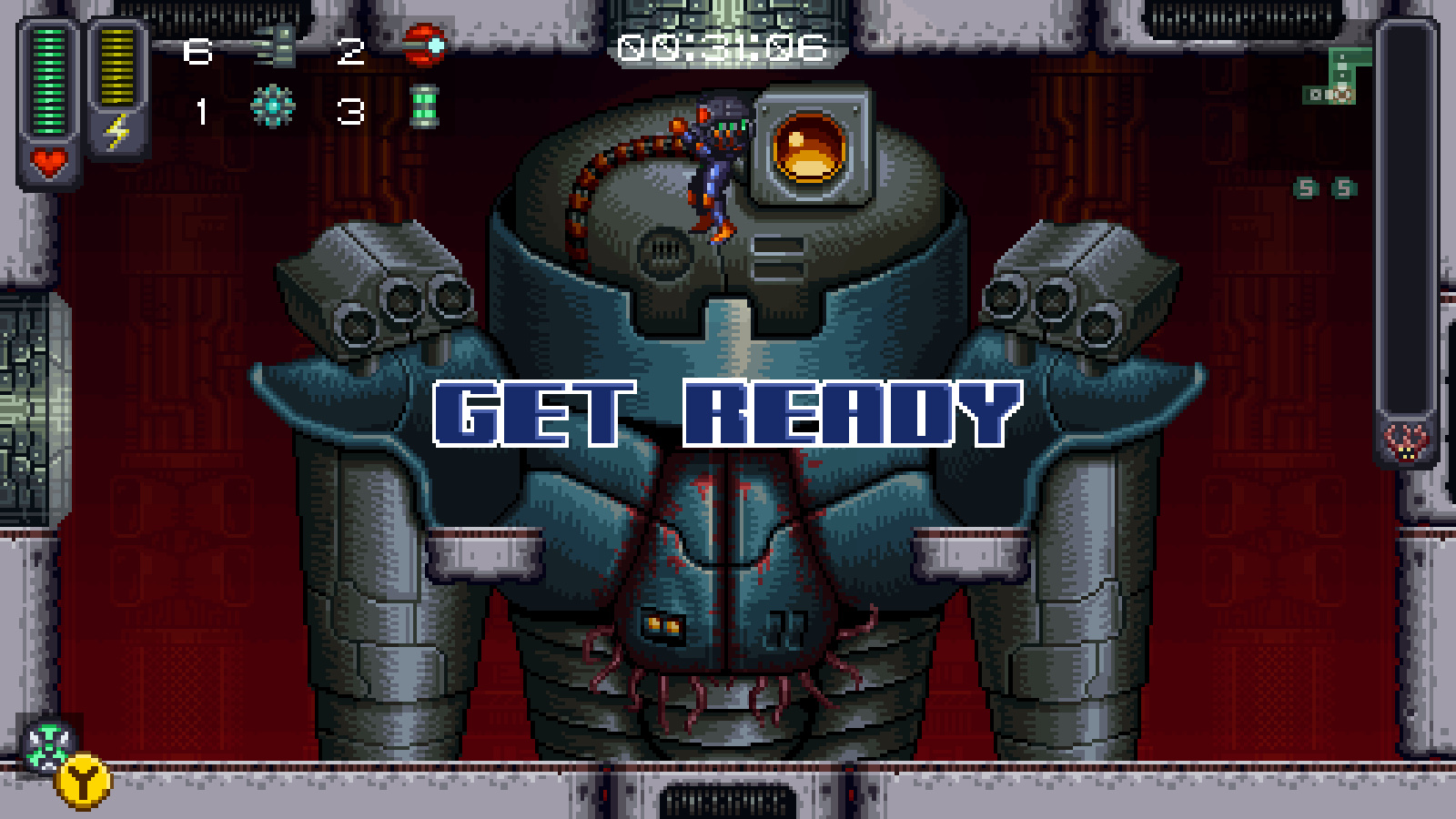
Even though the general path of your progression remains the same in each run, how that progression takes place varies greatly. An upgrade is always needed to reach the boss of an area, yet just which upgrade that is changes with every run. For example, on one run the path to the second boss may be blocked off by a high wall that you need the double jump for while on another run you might need the lightning gun to hit a switch embedded in the wall. Beyond affecting your own capabilities, these changes affect the pool of rooms the game will throw at you; rooms with embedded switches won’t appear if the run doesn’t contain an upgrade for hitting those switches. These changes aren’t always exciting, such as the presence of a heat-resistant suit leading to the creation of ‘hot’ versions of rooms which are otherwise identical to their normal versions, but in many cases the map is impacted by which items spawn and where those items spawn.
The upgrades themselves are particularly varied. Just about every type of upgrade has multiple forms it can take. Going back to the lightning example, there are at least four different upgrades which could spawn when the map has switches embedded in walls. You could get a lightning upgrade for your basic gun, which gives your bullets a lightning property and allows you to charge your shots or you could just get an entirely separate lightning gun which uses up energy when you toggle to it and rapidly damages nearby enemies with a lightning beam.
Alternately, you could get nothing lightning-related at all and get an incredibly powerful, incredibly costly rail gun which, beyond hitting switches, can annihilate any normal enemy in a single hit or you might get a passive phasing upgrade for the default gun which lets its bullets travel through walls, making it a fantastic weapon for taking out enemies from behind cover. Likewise, the upgrade hidden beyond the fourth boss is always something which lets you reach the final boss, but it can be anything from a jetpack to the ability to reverse gravity.
Beyond variants of upgrades which serve a similar purposes, there are also quite a few different types of upgrades. Stat upgrades exist which each give small boosts to things like health, weapon energy, attack power, firing rate, and so on. Individual stat upgrades don’t have much impact, but they all add up by the end. There are plenty of new weapons to find alongside passive upgrades for your base gun, some of which are mandatory for progression and others which are entirely optional, like the triple shot.
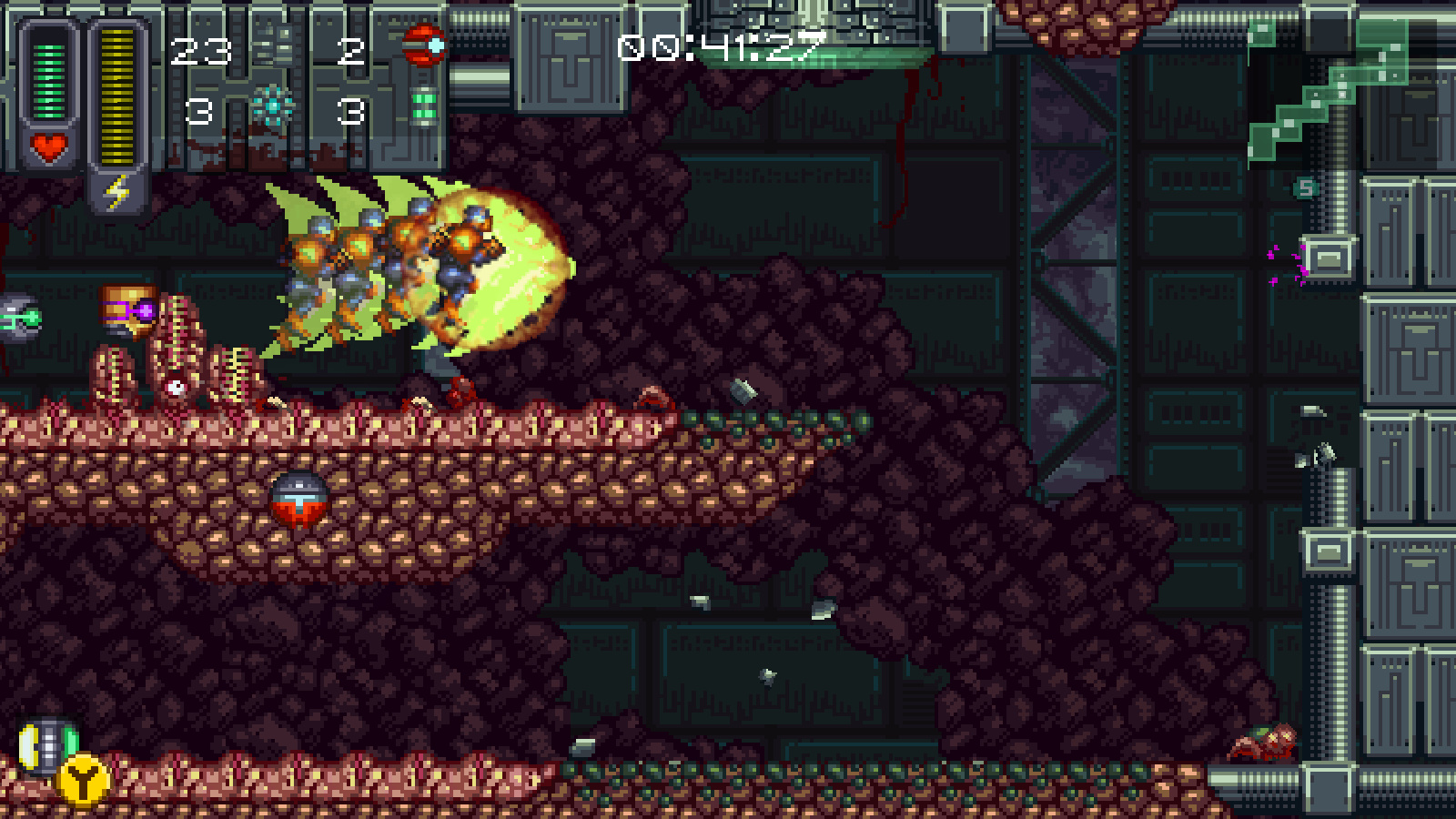
Sub-items also exist; you can only carry one at a time and they pull from the same pool of energy as your weapons, but they can do neat things like converting energy into health or damaging every enemy in a room, even the offscreen ones. Armor and helmet upgrades are less common, though they often provide useful functions, such as lighting dark rooms, or significantly change your stats, such as by reducing your max health in exchange for more speed, and they’re all rather nice – even the heat-resistant armor gives you a fiery counterattack. While not strictly an upgrade, you may also stumble across one or two or so ‘save’ stations which will each revive you a single time, serving as valuable extra lives for your run.
Orbs are my personal favorite type of upgrade. Aside from the light orb, all of these little helpers are always entirely optional. Orbs are pretty much just what they sound like, metal spheres that fly around near you. They’re always active, don’t cost any energy to use, and there’s no limit on how many you can have simultaneously. I like them so much because of just how completely different most of them are.
Some are offensive in nature, such as one which will home in on nearby enemies and latch on until they die and another which shoots alongside you for a small, consistent damage boost. Others are more defensive in nature, such as one which spawns healing items when enemies are nearby and another which simply serves as a floating shield to block projectiles. Yet others still are more for utility, like one which hovers over the exact location of nearby hidden upgrades.
The only orb I don’t like is the ‘moth orb’, which flies over to nearby scrap (currency) and turns it into nanobots; it’s hard to get money when your support item keeps eating it and the nanobots themselves go away quickly and sometimes cause additional trouble by breaking open enemy eggs or by attacking an enemy which splits into more enemies. Moth orb aside, orbs are just consistently fun upgrades to get and I wish there were more of them.
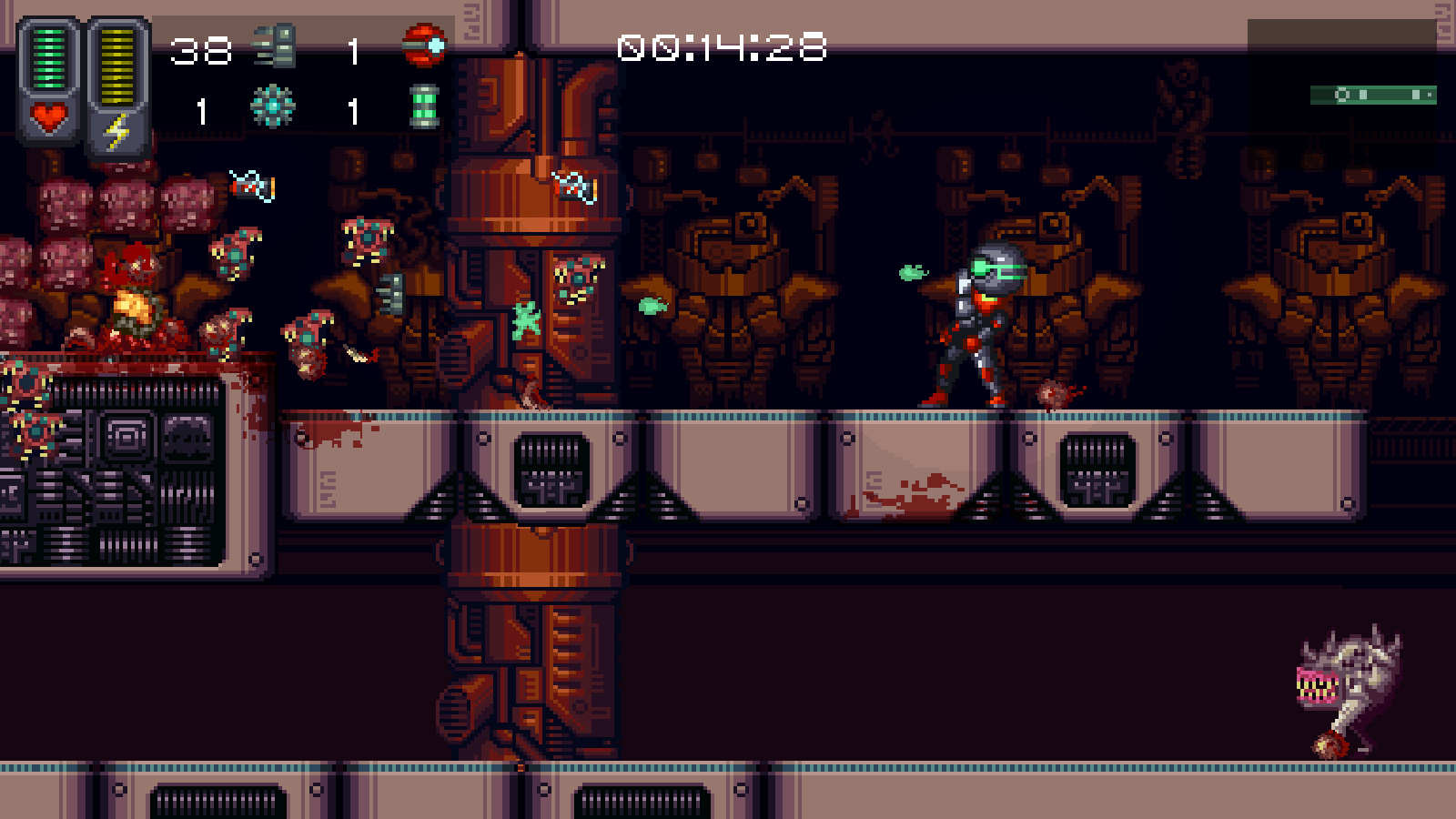
Archaic scraps are the final type of upgrade and these things are one of those snags I mentioned earlier. Archaic scraps come in three colors, red, blue, and green, and they are used for crafting. You see, some of the optional upgrades you can get come from NPC’s who will craft them at the cost of one or two specific archaic scraps and 15 or so normal scraps from enemies. This is all fine in concept, but it’s somewhat sloppy in its execution for two reasons.
First, there’s no guarantee that you’ll get the specific archaic scraps you need for an NPC in the same area as that NPC; you could very well find nothing but red and blue scraps in the second area while the only NPC around requires green ones or some similar issue. In such a situation, you would almost certainly still find green scraps down the road, but then it becomes a question of tedium rather than challenge – do you want to backtrack all the way through your current area and a chunk of the previous one for the sake of one or two upgrades?
The second issue is that archaic scraps tend to be far too common. You might not always have the exact color(s) you need, but your inventory will inevitably overflow with more scraps than you could ever use if you’re going for a 100% run. This is an issue because it means scraps which are literally useless to your run can spawn in locations that would otherwise potentially contain more useful things like stat upgrades. It also means that you sometimes might follow a series of rooms only to have the ‘prize’ at the end be a scrap you don’t need. I have no idea what the current formula is for determining the number and type of archaic scraps spawned, but I do think it should be adjusted to more closely match the number of type of scraps required by NPC’s.
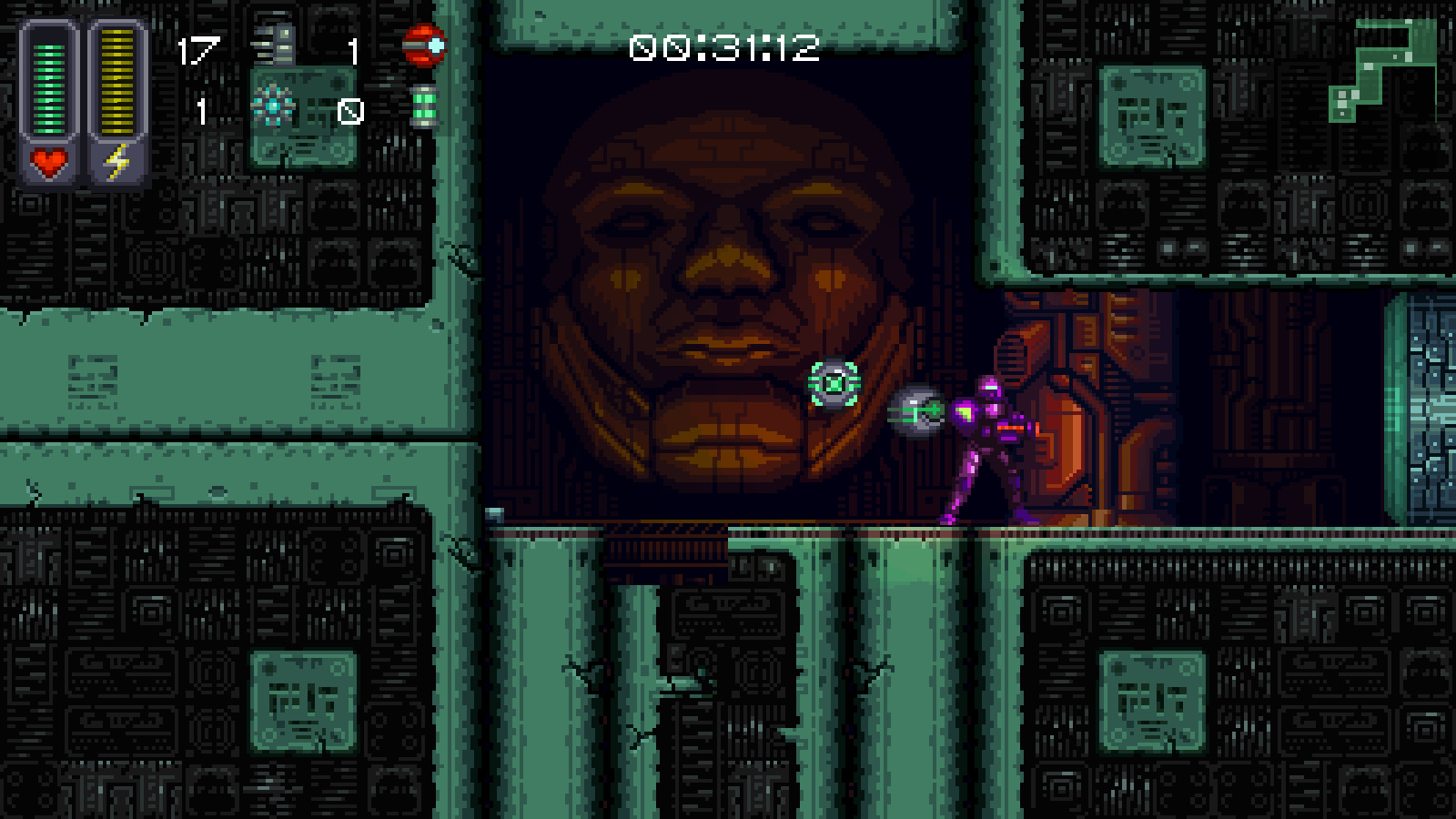
The other, more serious, snag the procedural generation runs into is a matter of quantity. Specifically, there are enough rooms that you’re unlikely to encounter the same one twice within a single run, but you’ll almost certainly see a few repeats even by the second run, assuming you fully explore the map. The third and fourth areas both have a chance to be dark if a light-based upgrade exists in the previous area, which changes things up rather substantially. Likewise, climbing up a room in one run often has a distinctly different feel compared to climbing down it in another due to how your placement relates to that of the enemies.
Unfortunately, no amount of upgrade variation will change the fact that after a few runs you’ll be so familiar with many of the rooms that you’ll know how to deal with all their enemies and exactly where to shoot to uncover any secret upgrades. There are a few changes which occur after defeating the final boss a few times, but these are rather minor aside from the last one. Thankfully, this is the type of issue which can be reduced over time with content patches and the game is off to a strong start with an upcoming update which will add more variety to the overall shape of the map layout alongside the addition of an entirely new, optional area.
One element which deserves more praise than it likely gets is the minimap. To put it bluntly, the minimap in A Robot Named Fight is fantastic. It takes after the Metroid series somewhat by dividing itself into a grid where an open circle on a space indicates the presence of an item while a dot indicates that the item has been obtained. Unique markings are also reserved for bosses, NPC’s, and save stations. What puts this minimap a step above though is the fact that it fills in adjacent squares within the same room or directly beyond doors. This saves a ton of time when you’re looking for upgrades because it means you don’t need to step into every single space on the map just to check.
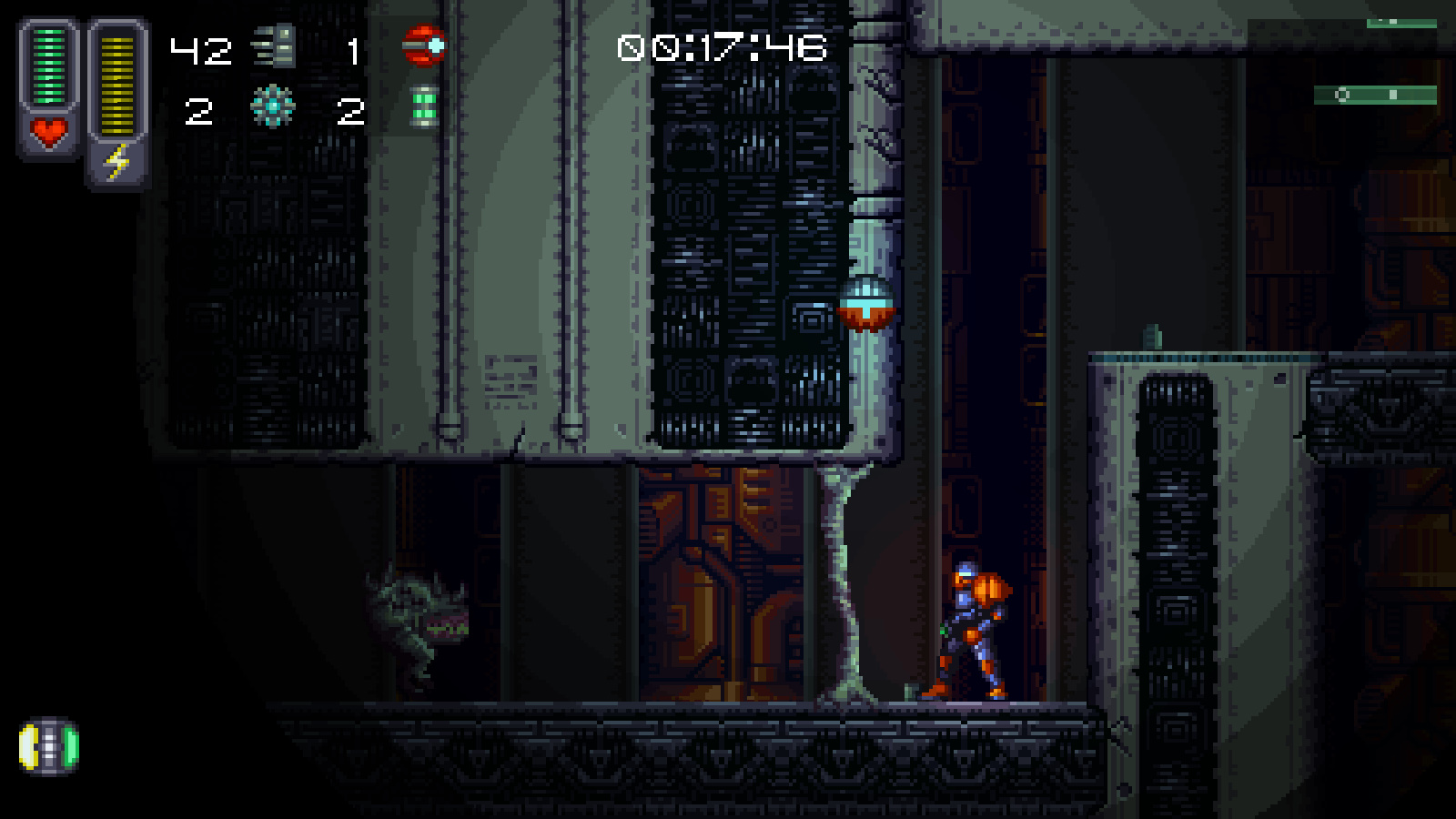
The minimap also comes in handy when you have multiple doors to choose from since you can quickly grab any upgrades immediately behind any doors before deciding on a path to follow more thoroughly. Beyond helping with locating upgrades, the minimap helps you to judge the shape and orientation of a room on the other side of a door if you pay attention to the walls, which can give you an idea of what types of obstacles to expect and the general direction a path is probably going to lead in.
A Robot Named Fight completely nails its aesthetic. The enemy designs are all creatively gross, many of them amount to little more than teeth, eyes, and/or bits of carapace attached to tumorous globs of animated flesh. A color palette filled with shades of brown, yellow, and red further enhances the disgusting nature of these creatures and contrasts them with more pleasant coloration of Fight and the other robots. The sheer amount of gore that explodes out of enemies when you kill them also helps to set the over-the-top tone, though it sometimes makes it difficult to notice some of the smaller enemy types.
The music is also fantastic, right down to the jingle that plays whenever you get an upgrade. Even the small amount of writing in the game goes a long way towards establishing the deliberately ridiculous tone, such as when the narrator in the opening cutscene says “…so that you may become fight enough to face the megabeast” in a dead serious tone.
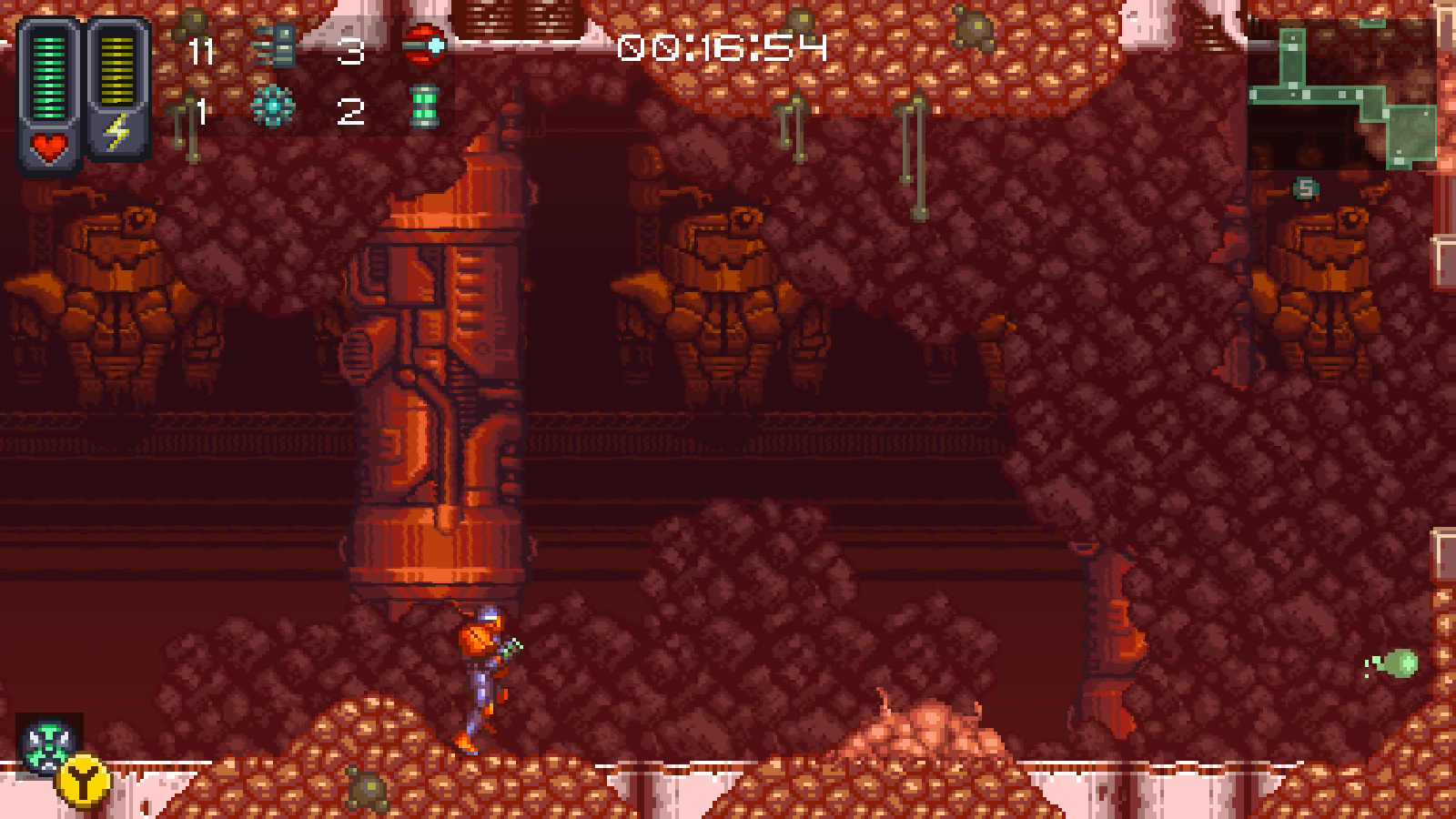
There are a few minor issues that I want to address before wrapping up this article. First, the camera could use a little work as it sometimes gets stuck in parts of larger rooms until you jump or otherwise move in a way that makes it begin to follow you again. A way to pan the camera down would also be very welcome in a game with so many vertical rooms as sometimes you’re forced to make leaps of faith onto platforms below you.
As for balance, beam attacks currently feel too strong and that goes both ways. Any sort of enemy laser or ‘vomit beam’ does extremely high damage and getting hit twice in a row from such attacks is usually enough to end a run. Likewise, your own rail gun weapon is so ridiculously strong that it seems to be capable of killing any given boss (final boss excluded) in two or three hits. Lastly, a helmet that changes things to make your scrap your health completely breaks the balance to your benefit. You can have up to 99 scrap while you’d normally only have about 15 health by the end of the game and you still only lose one scrap when hit by most attacks with this helmet. Unless you stumble across this helmet while nearly broke, the sheer amount of health you gain from it is basically equivalent to invincibility.
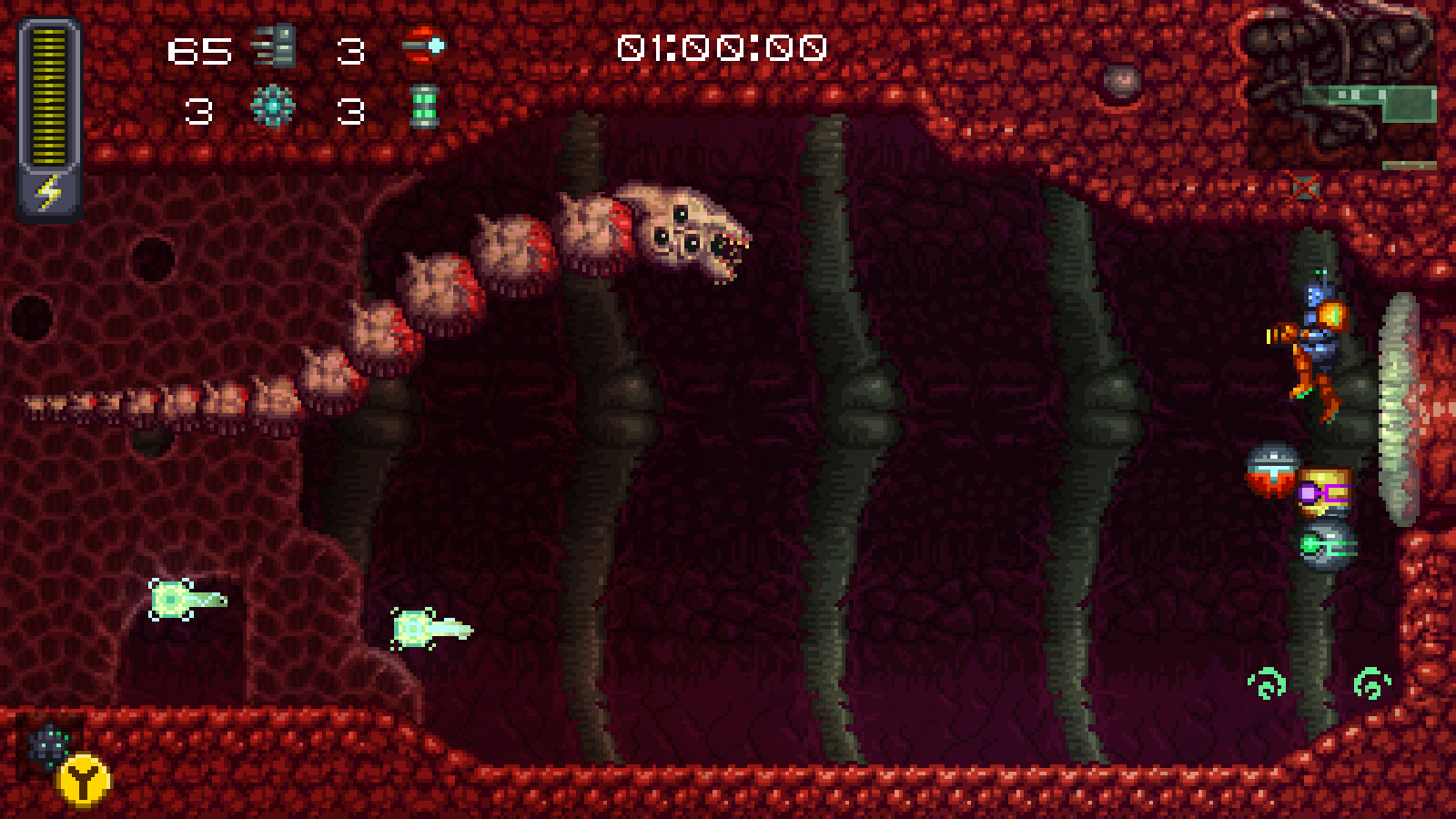
While A Robot Named Fight may have its share of issues, most of them are ultimately only minor annoyances which are difficult to even notice until after several runs. Overall, A Robot Named Fight stands out both as an action platformer and as a roguelike for its creative and varied set of upgrades, its exceptionally unusual setting, and its willingness to experiment with altering and combining familiar concepts to create an experience which is wholly its own.